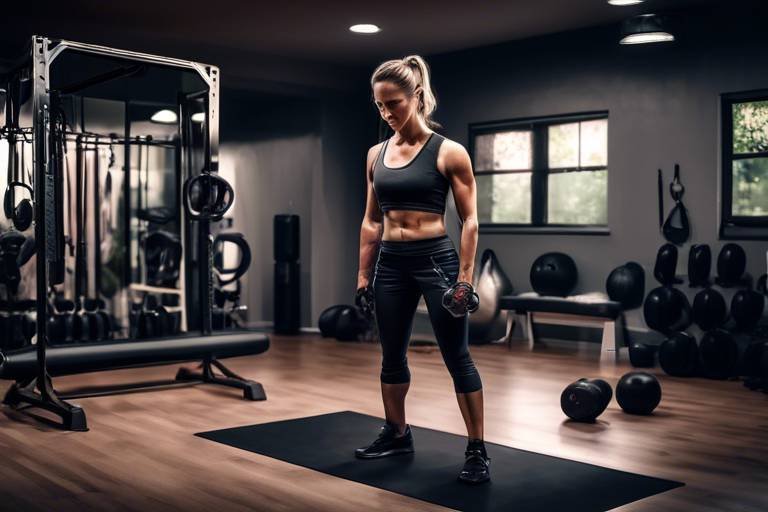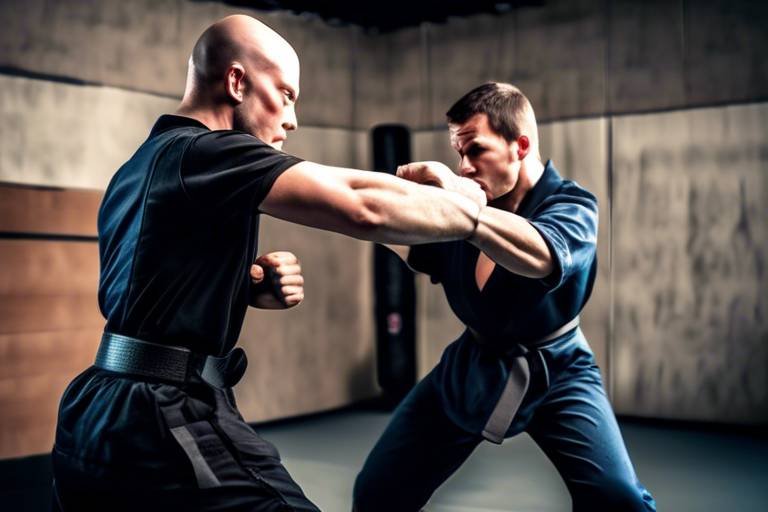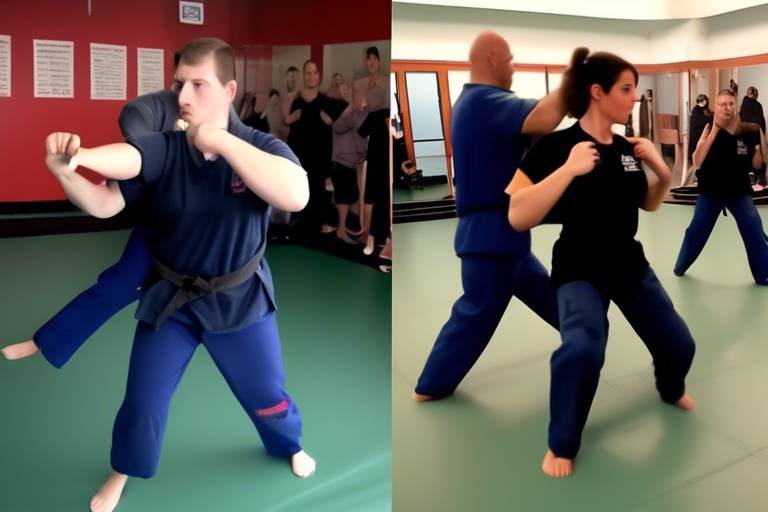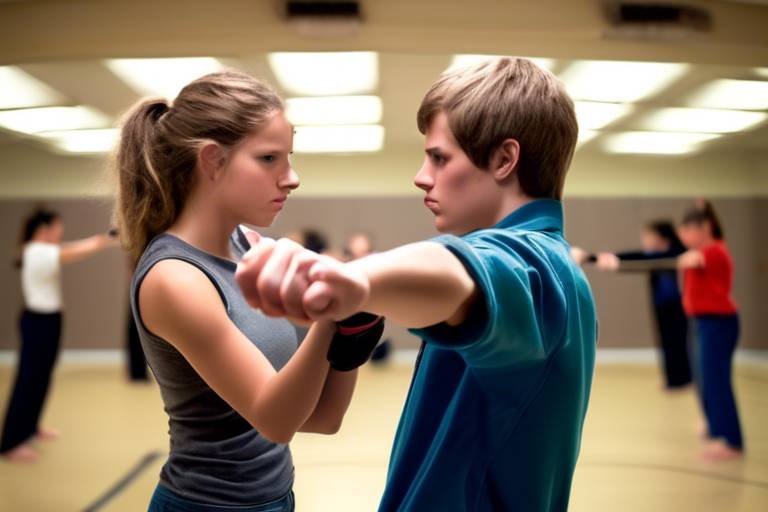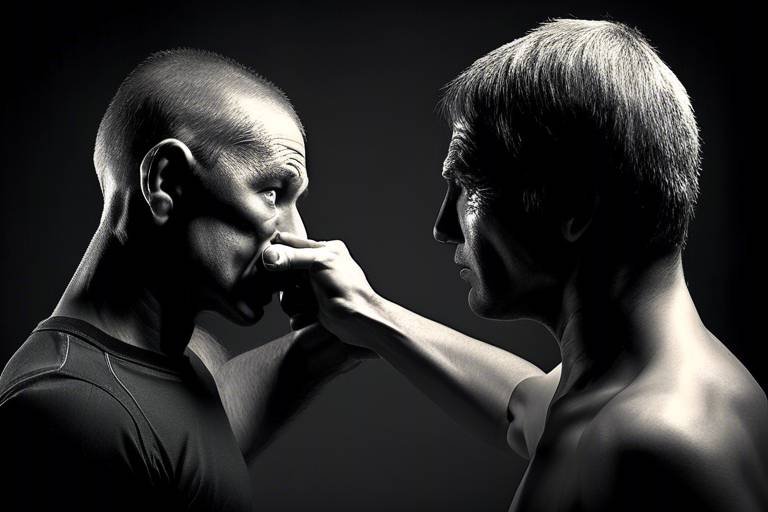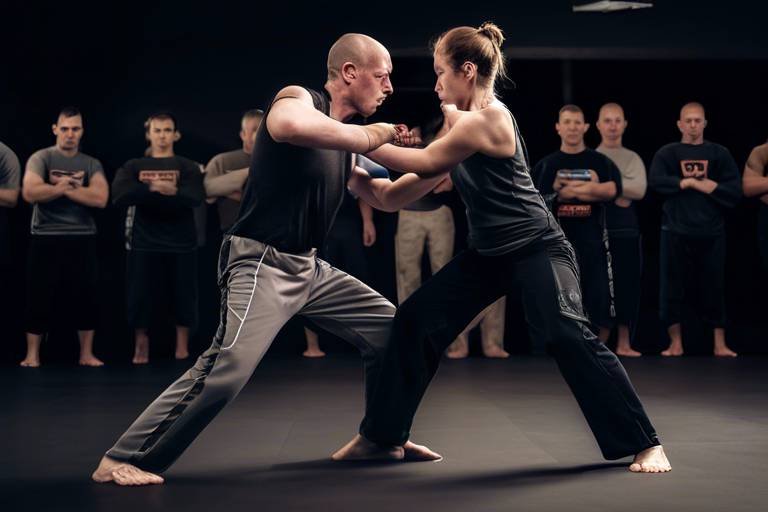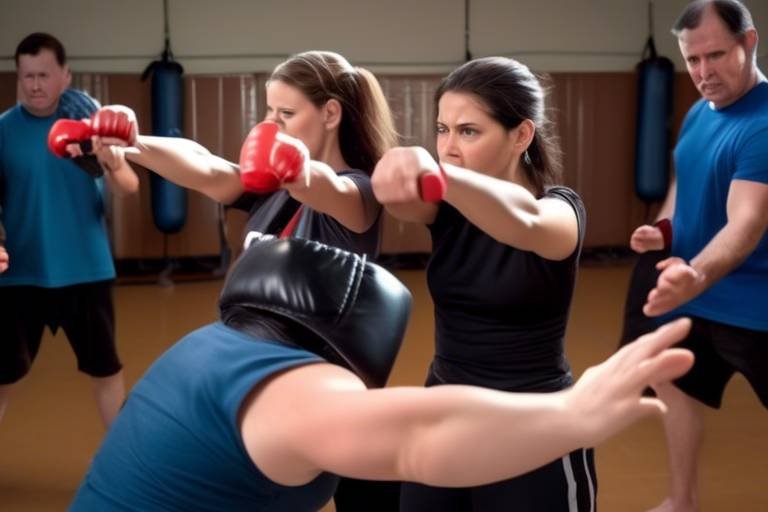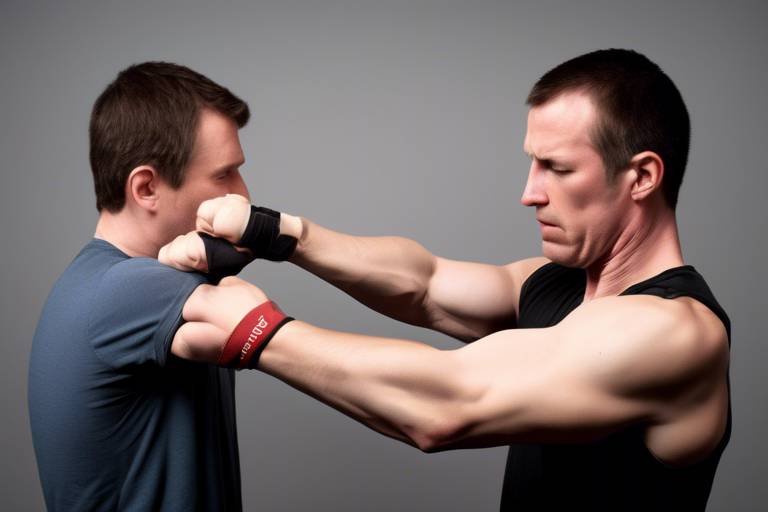Navigating Initial Challenges in Self-Defense Training – A Beginner’s Guide
Starting your journey in self-defense training can feel like stepping into a whole new world. The excitement of learning how to protect yourself is often accompanied by a myriad of challenges that can seem daunting at first. But fear not! This guide is designed to help you navigate those initial hurdles, ensuring you have a smoother and more effective learning experience. Whether you're looking to build confidence, improve your fitness, or simply learn how to defend yourself, understanding these challenges is the first step towards success.
Before diving into the training itself, it’s crucial to grasp the fundamental principles of self-defense. Self-defense isn’t just about physical techniques; it’s a mindset that combines awareness, preparedness, and the ability to react effectively in stressful situations. It’s important to comprehend the **legal implications** of self-defense as well. Different jurisdictions have various laws regarding what constitutes acceptable self-defense, and being informed can help you make better decisions in critical moments.
Moreover, cultivating the right mindset is essential for effective training. Think of it like preparing for a marathon; you wouldn’t just show up on race day without training. Similarly, self-defense requires mental preparation and a willingness to learn and adapt. Embrace the challenges, and remember that every expert was once a beginner!
When it comes to selecting a self-defense program, it can be overwhelming with so many options available. The key is to choose a program that aligns with your personal goals, fitness levels, and learning styles. Are you looking for something that emphasizes striking techniques, or are you more interested in grappling? Understanding your objectives will help narrow down your choices.
Also, consider the atmosphere of the training environment. A supportive and encouraging space can make a significant difference in your learning experience. Look for programs that offer trial classes, allowing you to gauge if it’s the right fit before committing.
With numerous martial arts styles to choose from, it’s essential to understand what each offers. Here’s a quick comparison of some popular styles that are often recommended for beginners:
| Martial Art | Focus | Best For |
|---|---|---|
| Krav Maga | Real-world self-defense | Practical application in dangerous situations |
| Brazilian Jiu-Jitsu | Ground fighting and submissions | Learning to defend against larger opponents |
| Muay Thai | Striking with fists, elbows, knees, and shins | Developing striking skills and conditioning |
For those just starting, some styles stand out due to their approachable nature and practical applications. **Krav Maga** is particularly known for its focus on real-world scenarios, making it an excellent choice for those looking to build confidence quickly. **Brazilian Jiu-Jitsu** offers a unique perspective by teaching you how to leverage technique over brute strength, which can be empowering for beginners. **Muay Thai**, with its emphasis on striking, can also be a fantastic way to improve fitness while learning effective self-defense techniques.
Once you’ve narrowed down your options, the next step is finding a qualified instructor. Look for someone who has a solid background in self-defense and a teaching style that resonates with you. A great instructor will not only teach you techniques but will also foster a supportive learning environment. Consider reaching out to current students for their feedback and insights on the instructor’s teaching methods.
Setting achievable goals is crucial in any training regimen, including self-defense. Instead of aiming to become a black belt overnight, focus on small, incremental achievements. This could be mastering a specific technique or improving your fitness level. Celebrating these small victories can keep you motivated and help you track your progress effectively.
As a beginner, you might encounter physical challenges that could hinder your training. Whether it’s low fitness levels or lack of flexibility, these obstacles are common and can be addressed with the right strategies. Start by incorporating basic strength and conditioning exercises into your routine. This doesn’t mean you need to hit the gym for hours; even short, focused workouts can make a significant difference.
Strength and endurance are vital for effective self-defense. Consider adding exercises like push-ups, squats, and planks to your routine. These can be done at home and require no special equipment. Gradually increasing the intensity and duration of your workouts will enhance your overall performance in self-defense scenarios.
Coordination and reflexes are essential skills for effective self-defense responses. Simple drills, such as shadow boxing or practicing footwork, can greatly enhance your agility and reaction time. Think of it like learning to dance; the more you practice the steps, the more fluid and instinctive your movements become.
Psychological challenges, such as fear and anxiety, are common among beginners. It’s natural to feel overwhelmed, but addressing these feelings is crucial for your growth. Techniques such as visualization and mindfulness can help you manage anxiety during training. By visualizing successful outcomes, you can build a positive mental framework that supports your learning.
Managing fear is an integral part of self-defense training. Start by acknowledging your fears and understanding that they are a normal part of the process. Gradually exposing yourself to more challenging scenarios in a controlled environment can help desensitize you to those fears, making them easier to handle over time.
Ultimately, consistent practice is the key to building confidence in your self-defense abilities. The more you practice, the more competent you will feel. Remember, confidence is not about being fearless; it’s about knowing you have the skills to handle whatever comes your way. So, get out there, train hard, and watch your confidence soar!
- What is the best martial art for beginners? It depends on your goals, but styles like Krav Maga, Brazilian Jiu-Jitsu, and Muay Thai are often recommended.
- How often should I train? Aim for at least 2-3 times a week to see significant progress.
- Do I need to be fit to start self-defense training? Not at all! Many programs cater to all fitness levels, and training will help improve your fitness over time.
- Can self-defense training help with confidence? Absolutely! As you learn and practice techniques, you’ll likely feel more confident in your abilities.

Understanding Self-Defense Basics
When you embark on the journey of self-defense training, it’s crucial to grasp the fundamental principles that underpin this practice. Self-defense isn’t just about learning a few moves; it’s about understanding the importance of personal safety, the legal implications of self-defense actions, and the mindset necessary for effective training. Think of it as building a strong foundation for a house; without it, everything else may crumble.
First and foremost, let’s talk about why self-defense is important. In today’s world, being able to protect oneself is not just a skill but a vital part of personal empowerment. Imagine walking down the street with confidence, knowing you have the ability to defend yourself if necessary. This sense of security can transform your daily life, allowing you to move freely without the constant shadow of fear.
Now, let’s dive into the legal implications. Understanding the laws surrounding self-defense in your area is essential. Did you know that what might be considered self-defense in one state could land you in serious trouble in another? It’s crucial to educate yourself about the laws governing self-defense, including what constitutes reasonable force and when it’s appropriate to use it. This knowledge not only protects you legally but also helps you make better decisions in high-pressure situations.
Next, we need to address the mindset required for effective self-defense training. It’s not just about physical ability; it’s also about mental readiness. You should cultivate a mindset that embraces awareness and assertiveness. This means being conscious of your surroundings and having the confidence to act if a situation escalates. Think of it as being a chess player, always anticipating your opponent’s next move. By developing this mindset, you’ll be better prepared to respond to potential threats.
As you delve deeper into your training, remember that self-defense is not a one-size-fits-all approach. Different situations may require different responses, and that’s where the beauty of various techniques comes into play. Here’s a quick overview of what you should focus on:
| Aspect | Importance |
|---|---|
| Personal Safety | Empowers you to protect yourself |
| Legal Knowledge | Prevents legal repercussions |
| Mindset | Prepares you mentally for encounters |
In conclusion, understanding the basics of self-defense is not just about mastering techniques; it’s about fostering a comprehensive approach that encompasses legal knowledge, mental preparedness, and personal empowerment. As you continue on your self-defense journey, keep these principles in mind. They will serve as your guiding lights, helping you navigate the often complex world of personal safety.
- What is self-defense? Self-defense refers to the use of reasonable force to protect oneself from harm.
- Is self-defense legal everywhere? Laws vary by location; it's important to understand local laws regarding self-defense.
- Do I need prior experience to start training? No, self-defense training is designed for individuals of all skill levels.
- How long does it take to learn self-defense? The time varies by individual, but consistent practice can lead to noticeable improvement in a few months.

Choosing the Right Training Program
When it comes to self-defense training, one size definitely does not fit all. Each person's journey is unique, shaped by their individual goals, fitness levels, and preferred learning styles. So, how do you choose the right program that will not only keep you engaged but also help you grow? The first step is to think about what you hope to achieve. Are you looking to build confidence, improve fitness, or acquire practical skills for real-life situations? Understanding your motivations will guide you toward the right training path.
Next, consider your fitness level. If you're just starting out or have been away from physical activity for a while, you might want to look for programs that cater to beginners. Many self-defense classes emphasize building foundational skills before diving into more complex techniques. This approach not only helps you learn at a comfortable pace but also reduces the risk of injury. On the flip side, if you're already active and looking for a challenge, you might want to explore programs that push your limits and offer advanced techniques.
Another essential factor to consider is your learning style. Some people thrive in a structured environment with clear instructions and a set curriculum, while others prefer a more fluid approach that allows for creativity and exploration. Ask yourself: do you learn better through visual demonstrations, hands-on practice, or verbal explanations? Researching various training programs and attending a few trial classes can help you gauge which style resonates with you.
As you narrow down your options, it’s crucial to evaluate the instructors. A qualified instructor can make a world of difference in your training experience. Look for someone who is not only experienced in self-defense but also possesses strong teaching skills. A good instructor should be able to break down techniques, provide constructive feedback, and create a supportive environment where you feel comfortable asking questions. Don't hesitate to reach out to potential instructors and inquire about their backgrounds, teaching philosophies, and class structures.
Finally, consider the training environment. The atmosphere of a training facility can significantly impact your motivation and enjoyment. Look for a place that feels welcoming, safe, and encouraging. A positive environment can help you build camaraderie with fellow students, making your training experience more enjoyable and fulfilling. To help you visualize the key aspects of choosing the right training program, here’s a quick table summarizing the main points:
| Factor | Considerations |
|---|---|
| Goals | Confidence, fitness, practical skills |
| Fitness Level | Beginner-friendly vs. advanced programs |
| Learning Style | Visual, hands-on, or verbal |
| Instructor Quality | Experience, teaching skills, approachability |
| Training Environment | Welcoming, safe, and encouraging atmosphere |
Choosing the right self-defense training program is an important step in your journey. By taking the time to evaluate your goals, fitness level, learning style, instructor quality, and training environment, you can set yourself up for a rewarding and effective learning experience. Remember, the right program will not only teach you valuable skills but will also empower you to face challenges head-on, both on and off the mat.
- What should I look for in a self-defense program? Focus on your goals, fitness level, and learning style. Ensure the instructor is qualified and the environment is supportive.
- Can I join a self-defense class if I have no prior experience? Absolutely! Many programs are designed specifically for beginners.
- How do I know if the instructor is qualified? Look for certifications, experience in self-defense, and positive reviews from other students.

Evaluating Different Martial Arts
When it comes to self-defense training, the variety of martial arts available can feel overwhelming. Each style has its own unique techniques, philosophies, and historical backgrounds, making it essential to evaluate them carefully before diving in. After all, choosing the right martial art is like picking the right tool for a job; you want something that fits your needs perfectly. So, how do you decide which martial art is best for you? Let’s break it down.
First, consider what you want to achieve from your training. Are you looking for practical self-defense skills, or are you more interested in fitness and discipline? Different martial arts cater to different goals. For example, if your primary focus is on real-world self-defense, styles like Krav Maga or Brazilian Jiu-Jitsu may suit you best. These disciplines emphasize techniques that are effective in real-life situations, focusing on quick, efficient movements to neutralize threats.
On the other hand, if you’re drawn to the aesthetic and philosophical aspects of martial arts, you might find yourself interested in styles like Tai Chi or Aikido. While these may not be as directly applicable in a self-defense scenario, they offer valuable lessons in balance, control, and mental focus. It’s crucial to align your training with what resonates with you personally, as this will keep you motivated and engaged.
Another factor to consider is the physical demands of each martial art. Some styles require a high level of fitness and flexibility, while others are more accessible to beginners. For instance, Muay Thai is known for its intense conditioning and striking techniques, which may be challenging for someone just starting out. Conversely, Judo focuses on throws and grappling, which can be easier to learn for those who may not yet have high endurance or flexibility.
To help you evaluate different martial arts, here’s a brief comparison of some popular styles:
| Martial Art | Focus | Suitability for Self-Defense | Fitness Level Required |
|---|---|---|---|
| Krav Maga | Self-defense techniques | Very High | Moderate |
| Brazilian Jiu-Jitsu | Grappling and ground fighting | High | Moderate |
| Muay Thai | Striking and conditioning | High | High |
| Tai Chi | Balance and mindfulness | Low | Low |
| Aikido | Defensive techniques | Moderate | Low to Moderate |
As you can see, each martial art has its own strengths and weaknesses. Take the time to research and perhaps even attend a few introductory classes to get a feel for the different styles. Most importantly, trust your instincts. If a particular martial art resonates with you, that’s a sign it may be the right choice for your self-defense journey.
In conclusion, evaluating different martial arts is a personal journey that requires reflection on your goals, physical capabilities, and interests. Don’t hesitate to explore various options and remember that the best martial art for you is the one that inspires you to keep training and growing.
- What is the best martial art for beginners? It depends on your goals. Krav Maga and Brazilian Jiu-Jitsu are often recommended for practical self-defense.
- How long does it take to become proficient in a martial art? Proficiency varies by individual and the style practiced, but consistent training can lead to noticeable improvements within a few months.
- Do I need to be fit to start martial arts? Not necessarily! Many classes accommodate beginners and focus on building fitness over time.

Popular Styles for Beginners
When diving into the world of self-defense, it's crucial to choose a martial art that not only resonates with you but also equips you with practical skills. A few styles stand out as particularly beginner-friendly, each offering unique advantages and techniques. Let's explore some of these popular options that can set you on the right path.
Krav Maga is often hailed as one of the most effective self-defense systems. Developed by the Israeli military, it focuses on real-world situations and practical techniques. What makes Krav Maga appealing for beginners is its emphasis on instinctive movements and simple techniques that can be learned quickly. You won’t find complex katas or forms here; instead, you'll train to respond to threats in a straightforward manner. Imagine having the ability to react swiftly and effectively, just like a reflex action—this is what Krav Maga aims to instill in its practitioners.
Another excellent choice is Brazilian Jiu-Jitsu (BJJ). This martial art emphasizes ground fighting and submission grappling, making it particularly effective for self-defense against larger opponents. The beauty of BJJ lies in its principle that a smaller, weaker person can successfully defend themselves against a bigger, stronger assailant by using technique and leverage. Beginners often find BJJ engaging because of its focus on sparring and live drills, which can be both challenging and fun. It’s like playing a chess game where your opponent is right there in front of you, constantly testing your strategy and skills.
Muay Thai, known as the "Art of Eight Limbs," is another fantastic option. This striking art utilizes punches, kicks, elbows, and knees, providing a comprehensive approach to stand-up fighting. Beginners can appreciate Muay Thai for its straightforward techniques and the physical conditioning it offers. Training in Muay Thai not only teaches you how to strike effectively but also builds your endurance and strength. Think of it as a full-body workout that equips you with powerful skills while also giving you a rush of adrenaline as you learn to throw those kicks and punches.
Each of these styles offers a unique flavor of self-defense training. Whether you prefer the instinctive responses of Krav Maga, the grappling techniques of Brazilian Jiu-Jitsu, or the striking prowess of Muay Thai, there’s something for everyone. As you consider your options, think about what excites you the most and aligns with your personal goals. The right choice will not only make your training enjoyable but will also empower you with the skills you need to defend yourself effectively.
In summary, starting your self-defense journey doesn’t have to be overwhelming. With styles like Krav Maga, Brazilian Jiu-Jitsu, and Muay Thai, beginners can find a path that suits their interests and physical capabilities. Remember, the key is to stay engaged and choose a style that motivates you to keep training!
- What is the best martial art for self-defense? It depends on personal preference, but Krav Maga, Brazilian Jiu-Jitsu, and Muay Thai are all excellent options for beginners.
- How long does it take to become proficient in self-defense? Proficiency varies by individual, but consistent training over several months can significantly improve your skills.
- Do I need to be fit to start self-defense training? No, many programs cater to all fitness levels, and training can help improve your fitness over time.
- Can women benefit from self-defense training? Absolutely! Self-defense training is beneficial for everyone, regardless of gender, as it builds confidence and skills to handle potential threats.

Finding Qualified Instructors
When it comes to self-defense training, the instructor you choose can make or break your experience. A qualified instructor not only imparts essential techniques but also fosters a supportive learning environment that encourages growth and confidence. So, how do you find an instructor who truly meets your needs? Let's explore some key factors to consider.
Firstly, it's crucial to look for instructors with certifications and a solid background in self-defense or martial arts. Many reputable organizations offer certifications that ensure instructors have undergone rigorous training and possess the necessary skills to teach effectively. Don't hesitate to ask potential instructors about their qualifications; a good instructor will be proud to share their credentials.
Next, consider the teaching style of the instructor. Some may adopt a more traditional approach, focusing on form and discipline, while others might prioritize practical scenarios and adaptability. If you enjoy a more hands-on, dynamic learning experience, look for instructors who emphasize real-life applications of techniques. You can often gauge this by attending a trial class or observing a session.
Another important aspect is the class size. Smaller classes often allow for more personalized attention, which can be beneficial for beginners who may need extra guidance. In contrast, larger classes might provide a broader range of experiences but can sometimes leave students feeling lost in the crowd. Think about what kind of learning environment you thrive in and seek out instructors who offer that.
Additionally, don't overlook the reputation of the instructor and the school. Look for reviews or testimonials from former students. You can also ask around in local community groups or online forums dedicated to self-defense. A well-regarded instructor will have a track record of satisfied students who have successfully progressed in their training.
Lastly, consider the location and schedule of the classes. An instructor might be fantastic, but if their classes are too far away or don’t fit your schedule, it could hinder your commitment to training. Look for options that are convenient for you, as consistency is key in self-defense training.
In summary, finding a qualified self-defense instructor involves a mix of research, personal preference, and practical considerations. By focusing on certifications, teaching styles, class sizes, reputations, and logistical factors, you can make an informed decision that sets you on the path to success in your self-defense journey.
- What qualifications should I look for in a self-defense instructor? Look for instructors with recognized certifications, experience in teaching, and a good reputation within the community.
- How can I assess an instructor’s teaching style before committing? Attend a trial class or watch a session to see if their teaching style aligns with your learning preferences.
- Is it better to train in a large class or a smaller one? Smaller classes generally offer more personalized attention, which can be beneficial for beginners.
- How important is the location of the training? Convenient locations can help you stay committed to your training schedule, making it easier to attend classes regularly.

Setting Realistic Goals
When it comes to self-defense training, one of the most crucial elements for beginners is . Think of your journey in self-defense like climbing a mountain; you wouldn't attempt to reach the summit without first mapping out your route and understanding the terrain. Similarly, having clear, achievable goals not only keeps you motivated but also helps you track your progress effectively. So, how do you go about establishing these goals?
First and foremost, it's essential to recognize that self-defense is a skill that takes time to develop. Expecting to become a black belt in a few weeks is like expecting to run a marathon after a month of training—it’s simply not realistic. Instead, focus on short-term objectives that build upon each other. For instance, you might start with a goal of mastering basic stances or understanding fundamental techniques within the first month of training.
Another effective strategy is to break your larger goals into smaller, manageable milestones. For example, if your ultimate aim is to feel confident in defending yourself in various situations, consider setting specific milestones such as:
- Learning three key self-defense moves by the end of the first month.
- Practicing these moves with a partner at least twice a week.
- Participating in a sparring session to apply your skills in a controlled environment.
By breaking down your goals, you create a roadmap that allows for gradual improvement. This not only makes the process less overwhelming but also provides opportunities for celebrating small victories along the way. And let’s be honest, who doesn’t love a good reason to celebrate?
Moreover, consider your personal circumstances when setting these goals. Factors such as your current fitness level, time availability, and previous experience in martial arts can all influence what is achievable for you. For instance, if you’re starting from scratch in terms of fitness, it might be more realistic to aim for consistent attendance in training sessions rather than trying to perfect advanced techniques right away.
Lastly, don’t forget the importance of flexibility in your goal-setting. Life can throw unexpected challenges your way—be it work commitments, family responsibilities, or even injuries. It’s okay to adjust your goals as needed. The key is to stay committed to your training while being adaptable in your approach.
In summary, setting realistic goals in self-defense training is about understanding your journey, breaking down your objectives into manageable steps, and remaining flexible. By doing so, you’ll not only enhance your learning experience but also foster a sense of achievement that will keep you motivated to continue your self-defense journey.

Overcoming Physical Limitations
Starting self-defense training can feel like stepping into a whole new world, especially when you realize that your body might not be as agile or strong as you’d like it to be. But fear not! Overcoming physical limitations is not just possible; it's a journey that can lead to incredible personal growth. Just like a caterpillar transforms into a butterfly, you too can evolve through consistent effort and the right strategies. Let's dive into some practical approaches that can help you tackle these challenges head-on.
First off, it’s essential to acknowledge that everyone has different starting points. Some may be seasoned athletes, while others might be just getting back into fitness after a long break. The key is to embrace your unique journey and focus on gradual improvement. Setting realistic expectations is crucial; don’t compare your progress to others. Instead, celebrate small victories along the way, whether it's completing an extra push-up or executing a technique with better form.
One of the primary physical challenges beginners face is fitness level. If you find yourself winded after a short warm-up, don’t worry! Incorporating a balanced routine of strength and conditioning exercises can significantly enhance your performance. Here’s a simple weekly plan to get you started:
| Day | Exercise | Duration |
|---|---|---|
| Monday | Strength Training (Bodyweight) | 30 minutes |
| Tuesday | Cardio (Running/Walking) | 20 minutes |
| Wednesday | Flexibility (Yoga or Stretching) | 30 minutes |
| Thursday | Strength Training (Weights) | 30 minutes |
| Friday | Cardio (Cycling) | 20 minutes |
| Saturday | Rest or Light Activity | - |
| Sunday | Active Recovery (Walking or Swimming) | 30 minutes |
In addition to building strength, improving your coordination and reflexes is equally important for effective self-defense. Think of your body as a finely tuned machine; every part must work in harmony. Incorporating exercises like agility drills, balance training, and even dance can enhance your coordination. For example, practicing footwork drills can help you move more efficiently during training, making it easier to evade attacks.
Furthermore, don’t underestimate the power of flexibility. A flexible body can react faster and with greater range of motion, which is essential in self-defense scenarios. Regular stretching or yoga can significantly improve your flexibility over time. Imagine being able to execute a high kick or a swift dodge with ease—that’s the magic of flexibility!
Lastly, remember that overcoming physical limitations is not just about the body; it’s also about the mind. Your mindset plays a crucial role in how you perceive your physical abilities. Cultivating a positive attitude and a growth mindset can help you push through the tough days. Instead of thinking, “I can’t do this,” try shifting your perspective to, “I’m learning and improving every day.”
In conclusion, overcoming physical limitations in self-defense training is a multi-faceted approach that requires patience, dedication, and a bit of creativity. By focusing on building strength, improving coordination, and maintaining a positive mindset, you can transform your training experience into one that is not only effective but also enjoyable. Remember, every expert was once a beginner, so keep pushing forward, and soon enough, you’ll surprise yourself with what you can achieve!
- How long does it take to see improvements in physical fitness for self-defense?
Improvements can vary based on individual effort and consistency, but many people start to notice changes within a few weeks of regular training.
- What if I have previous injuries?
Always consult with a healthcare professional before starting any new training program, and consider working with instructors who are knowledgeable about injury modifications.
- Can I practice self-defense without being in great shape?
Absolutely! Self-defense training can be adapted to your current fitness level, and many techniques can be practiced at a slower pace until you build strength and endurance.

Building Strength and Endurance
When it comes to self-defense training, is not just beneficial; it's essential. Think of your body as the vehicle that will carry you through challenging situations. Just like a car needs a strong engine and reliable tires to perform well, your body needs strength and stamina to execute self-defense techniques effectively. But how do you go about enhancing these attributes? Let's dive into some practical strategies!
First off, incorporating a balanced mix of strength training and cardiovascular exercises into your routine can significantly improve your performance. Strength training can include exercises like push-ups, squats, and weightlifting, which help build muscle mass and power. On the other hand, cardiovascular workouts—think running, cycling, or swimming—are crucial for enhancing your endurance, allowing you to maintain energy levels during prolonged self-defense scenarios.
Here’s a simple weekly plan to get you started:
| Day | Activity |
|---|---|
| Monday | Strength training (Upper body) |
| Tuesday | Cardio (30 minutes running) |
| Wednesday | Strength training (Lower body) |
| Thursday | Cardio (Cycling) |
| Friday | Strength training (Core) |
| Saturday | High-Intensity Interval Training (HIIT) |
| Sunday | Rest and recovery |
As you engage in these activities, remember to listen to your body. It's important to gradually increase the intensity and duration of your workouts to avoid injury. If you're just starting out, you might want to focus on mastering your body weight before adding additional weights. Also, consider incorporating functional training exercises, which mimic real-life movements and can enhance your agility and strength in self-defense situations.
Another key aspect of building strength and endurance is nutrition. Fueling your body with the right nutrients can make a world of difference. Think of your body as a high-performance machine that needs quality fuel. Focus on a balanced diet rich in proteins, healthy fats, and complex carbohydrates. Foods such as lean meats, nuts, whole grains, and plenty of fruits and vegetables will provide the energy you need to power through your workouts and recovery.
Finally, don't underestimate the power of rest and recovery. Just as a car needs downtime to function optimally, your body also requires rest to repair and strengthen itself. Getting adequate sleep and taking rest days can help prevent burnout and injuries, ensuring that you stay on track with your training.
In conclusion, building strength and endurance is a multifaceted journey that involves a combination of exercise, nutrition, and rest. By following a structured training plan, listening to your body, and fueling it properly, you'll not only enhance your self-defense skills but also boost your overall health and well-being.
- How long does it take to build strength and endurance? It varies by individual, but with consistent training, noticeable improvements can be seen in as little as 4-8 weeks.
- Can I build strength without weights? Absolutely! Bodyweight exercises like push-ups, squats, and lunges are excellent for building strength.
- What should I eat to support my training? Focus on a balanced diet with plenty of proteins, healthy fats, and complex carbs to fuel your workouts.
- How important is rest in a training program? Very important! Rest allows your muscles to recover and grow, preventing injuries and ensuring long-term progress.

Improving Coordination and Reflexes
When it comes to self-defense, having sharp coordination and quick reflexes can be the difference between escaping danger and getting caught off guard. Imagine trying to catch a fast-moving ball; if your hand-eye coordination isn’t on point, you’ll likely miss it entirely. The same principle applies in self-defense scenarios, where every second counts. So, how can you enhance these vital skills? Let’s dive into some effective strategies that can help you become more agile and responsive.
First off, incorporating dynamic drills into your training routine is a fantastic way to boost your coordination. These drills often involve repetitive movements that mimic real-life self-defense situations. For instance, practicing footwork drills not only helps you move quickly but also improves your balance and stability. You can set up a simple obstacle course or use agility ladders to challenge yourself. As you navigate these courses, your brain and body will work together, enhancing your reflex responses.
Another effective method is to engage in partner drills. Working with a partner allows you to practice techniques in a controlled environment, where you can react to their movements. For example, you might practice blocking and countering strikes, which requires you to stay alert and responsive. This kind of interactive training simulates real-world scenarios, helping you develop quicker reflexes over time. Remember, the more you practice responding to unpredictable movements, the better you’ll become at anticipating and reacting to potential threats.
Moreover, consider adding reaction time exercises to your training. These can be as simple as catching a ball thrown at you unexpectedly or using reaction lights that turn on randomly. The goal is to train your brain to respond swiftly to visual cues. You can also try shadow boxing, where you visualize an opponent and react to imaginary attacks. This not only sharpens your reflexes but also boosts your confidence in your ability to defend yourself.
To wrap it up, improving your coordination and reflexes requires a combination of practice, patience, and persistence. Here’s a quick summary of key strategies:
- Incorporate dynamic drills into your routine.
- Engage in partner drills to simulate real-life encounters.
- Practice reaction time exercises to sharpen your responsiveness.
By focusing on these areas, you’ll be well on your way to becoming a more effective self-defense practitioner, ready to handle whatever comes your way!
Q: How long does it take to improve coordination and reflexes?
A: Improvement varies from person to person, but with consistent practice, many individuals notice significant enhancements within a few weeks to a couple of months.
Q: Are there specific exercises that can help with coordination?
A: Yes! Exercises like jumping rope, balance drills, and agility ladder workouts are excellent for improving coordination.
Q: Can age affect my ability to improve coordination and reflexes?
A: While age can play a role, people of all ages can improve their coordination and reflexes with the right exercises and training.
Q: How often should I practice to see improvements?
A: Aim for at least 2-3 times a week, incorporating a mix of drills focused on coordination and reflex training.

Dealing with Mental Barriers
Embarking on a journey into self-defense training can be as exhilarating as it is daunting. For many beginners, the most formidable obstacles aren't physical; they lie within the mind. It's not uncommon to feel a surge of anxiety or fear when faced with the prospect of learning how to defend oneself. These mental barriers can manifest in various ways, from self-doubt to overwhelming fear of failure. But fear not! Understanding these barriers is the first step toward overcoming them.
One of the primary mental challenges beginners face is the fear of the unknown. Imagine standing at the edge of a diving board, peering down into the deep end for the first time. The water looks intimidating, and you can't shake the feeling that you might sink instead of swim. This analogy perfectly encapsulates the fear that often accompanies self-defense training. However, just like learning to swim, the key is to take that leap, one small step at a time.
To help manage and conquer these fears, it's essential to adopt a few practical strategies. First, consider visualization techniques. Picture yourself successfully executing a self-defense move. This mental rehearsal can significantly boost your confidence, making the actual practice feel less daunting. Additionally, practicing mindfulness can help ground your thoughts. Techniques such as deep breathing or meditation can calm your mind, allowing you to focus on the present moment rather than the 'what-ifs' that often cloud our judgment.
Another significant barrier is the fear of judgment from others. You might worry about looking foolish or clumsy in front of more experienced practitioners. It's crucial to remember that everyone starts somewhere, and most people in your training environment have faced similar feelings. Try to foster a supportive mindset by surrounding yourself with encouraging peers and instructors who celebrate progress, no matter how small. A positive training environment can work wonders for your confidence.
Building confidence through consistent practice is another effective way to tackle mental barriers. Just like a muscle, confidence grows stronger the more you use it. Set aside time each week to practice your techniques, even if it's just in front of a mirror or with a friend. As you become more familiar with the movements, you'll find that your anxiety diminishes, replaced by a sense of empowerment and control.
Moreover, consider keeping a journal of your training journey. Documenting your experiences, challenges, and victories can provide insight into your progress and help you recognize patterns in your fears. You'll likely find that what once seemed insurmountable becomes manageable through reflection and acknowledgment of your growth.
In conclusion, while mental barriers can feel overwhelming, they are not insurmountable. By employing visualization techniques, practicing mindfulness, fostering a supportive environment, engaging in consistent practice, and reflecting on your journey, you can dismantle these barriers. Remember, every expert was once a beginner, and the path to mastering self-defense is paved with perseverance and self-compassion.
- What are some common mental barriers in self-defense training?
Common mental barriers include fear of failure, anxiety about judgment from others, and self-doubt regarding one’s abilities.
- How can I overcome my fear of self-defense training?
Utilizing visualization techniques, practicing mindfulness, and surrounding yourself with supportive peers can help alleviate fear.
- Is it normal to feel anxious when starting self-defense classes?
Absolutely! Many beginners experience anxiety and fear, but these feelings can be managed with practice and a positive mindset.
- How important is consistent practice in building confidence?
Consistent practice is crucial as it helps reinforce skills, making you feel more competent and confident in your abilities.

Coping with Fear
Fear is a natural response, especially when you're stepping into the world of self-defense training. It's like standing at the edge of a diving board, looking down at the water below. Your heart races, your palms sweat, and every instinct screams at you to back away. But just as that leap into the pool can be exhilarating, facing your fears in self-defense can lead to empowerment and growth. So how do you cope with this fear? Let’s dive in!
First and foremost, it's essential to recognize that you're not alone in feeling this way. Almost every beginner experiences a wave of anxiety when starting self-defense training. The key is to acknowledge this fear rather than suppress it. By openly discussing your feelings with your instructor or fellow trainees, you can create a supportive environment where everyone understands and encourages one another. This camaraderie can significantly reduce feelings of isolation and fear.
Another effective strategy is to visualize your success. Before each training session, take a moment to close your eyes and picture yourself executing techniques flawlessly. Imagine yourself responding confidently to various scenarios. This mental rehearsal can create a positive mindset, making you less likely to be overwhelmed by fear when you're actually practicing. Visualization is like a mental warm-up; it prepares you for the challenges ahead.
Additionally, breaking down techniques into smaller, manageable steps can make a significant difference. Instead of trying to master an entire move at once, focus on one component at a time. For example, if you're learning a self-defense maneuver, concentrate on your stance first, then your grip, and finally the execution. This gradual approach not only builds your skills but also reduces anxiety, making each session feel less daunting.
Moreover, incorporating breathing exercises into your training routine can be a game-changer. When fear strikes, our breathing often becomes shallow and rapid, which can amplify feelings of panic. By practicing deep, controlled breaths, you can calm your mind and body. Try this simple technique: inhale deeply through your nose for a count of four, hold for four, and exhale slowly through your mouth for a count of six. Repeat this several times before and during your training to help center yourself.
Lastly, remember that progress takes time. Just like a flower doesn't bloom overnight, your confidence in self-defense will grow with consistent practice. Celebrate small victories along the way, whether it's successfully executing a technique or simply showing up for class despite your fears. These milestones will serve as reminders of your growth and resilience, further motivating you to push through any anxiety.
Q: Is it normal to feel scared when starting self-defense training?
A: Absolutely! Feeling scared is a common experience for beginners. Acknowledging your fear is the first step toward overcoming it.
Q: How can I improve my confidence in self-defense?
A: Consistent practice, visualization techniques, and supportive training environments are key to building confidence.
Q: What should I do if I feel overwhelmed during training?
A: Take a moment to breathe deeply and refocus. It's okay to take a break and discuss your feelings with your instructor or peers.

Building Confidence through Practice
Building confidence in self-defense is akin to constructing a sturdy house; it requires a solid foundation, consistent effort, and the right tools. When you first step onto the training mat, it’s easy to feel overwhelmed. But remember, every expert was once a beginner. The key to transforming that initial anxiety into confidence lies in consistent practice.
Imagine you're learning to ride a bike. At first, it feels daunting, and you might wobble or even fall. However, with each attempt, you gain balance and control. The same principle applies to self-defense. The more you practice your techniques, the more muscle memory develops, allowing you to react instinctively in real-life situations. This is why dedicating time to practice is crucial. It’s not just about memorizing moves; it’s about embedding them into your very being.
One effective way to enhance your practice is by simulating real-life scenarios. This not only helps you apply your techniques but also prepares your mind for the unexpected. For instance, during your training sessions, you might partner with someone to practice specific drills that mimic potential self-defense situations. This can range from escaping holds to defending against sudden attacks. Engaging in these realistic practices can significantly boost your confidence, as you become familiar with how to handle pressure and unpredictability.
Additionally, it's important to set incremental goals during your training. Instead of aiming to master every technique at once, focus on one or two skills per session. Celebrate small victories, whether it's successfully executing a particular move or improving your reaction time. This approach not only makes the learning process more manageable but also reinforces your sense of achievement, further fueling your confidence.
To illustrate this, let’s consider a simple table that outlines potential goals for a beginner in self-defense training:
| Skill | Goal | Timeline |
|---|---|---|
| Basic Stances | Master three stances | 1 Week |
| Simple Strikes | Execute 10 strikes correctly | 2 Weeks |
| Escape Techniques | Successfully escape from a hold | 3 Weeks |
| Combination Moves | Combine strikes and escapes fluidly | 1 Month |
As you progress, don’t forget to seek feedback from your instructors and peers. Constructive criticism can provide new insights and enhance your skills. It’s also a great way to build camaraderie within your training group, as everyone shares the same journey of growth and improvement.
Ultimately, the path to confidence in self-defense is paved with persistence and dedication. Every hour spent training is an investment in yourself. So, embrace the process, enjoy the journey, and watch as your confidence blossoms with each practice session. Remember, in self-defense, just like in life, it’s not about never falling; it’s about rising every time you do.
- How often should I practice self-defense techniques?
Consistency is key! Aim for at least 2-3 practice sessions per week to see significant improvement.
- What if I feel too anxious to practice in front of others?
It's normal to feel anxious. Start by practicing at home or with a trusted partner until you feel more comfortable.
- Can I practice self-defense alone?
Yes, many techniques can be practiced solo, such as shadow fighting or conditioning exercises. However, working with a partner can enhance your learning experience.
Frequently Asked Questions
- What is self-defense and why is it important?
Self-defense is the practice of protecting oneself from harm, using techniques that can include physical maneuvers, awareness, and avoidance strategies. It's important because it empowers individuals to handle potentially dangerous situations, enhances personal safety, and builds confidence.
- How do I choose the right self-defense training program?
When choosing a self-defense training program, consider your personal goals, fitness level, and preferred learning style. Research different programs, attend introductory classes, and speak with instructors to find a fit that resonates with you.
- What are some beginner-friendly martial arts styles?
Popular beginner-friendly styles include Krav Maga, which focuses on practical self-defense techniques; Brazilian Jiu-Jitsu, emphasizing ground fighting and submissions; and Muay Thai, known for its striking techniques. Each offers unique benefits for self-defense.
- How can I overcome physical limitations in training?
To overcome physical limitations, start by incorporating strength and conditioning exercises into your routine. Gradually increase your flexibility and endurance through consistent practice and tailored workouts, which can significantly enhance your self-defense skills.
- What mental barriers might I face during self-defense training?
Common mental barriers include fear and anxiety, which can hinder performance. It's essential to acknowledge these feelings and develop coping strategies, such as visualization and breathing techniques, to build a more focused mindset.
- How can I build confidence in my self-defense abilities?
Building confidence comes from consistent practice and gradual exposure to challenging scenarios. As you improve your skills and gain experience, you'll feel more competent and ready to handle real-life situations effectively.


